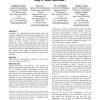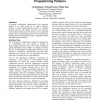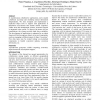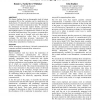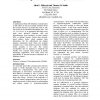CSCW
2000
ACM
14 years 7 months ago
2000
ACM
Social resources like trust and shared identity make it easier for people to work and play together. Such social resources are sometimes referred to as social capital. Thirty year...
CSCW
2000
ACM
14 years 7 months ago
2000
ACM
Companies are experimenting with putting teams into warrooms, hoping for some productivity enhancement. We conducted a field study of six such teams, tracking their activity, atti...
CSCW
2000
ACM
14 years 7 months ago
2000
ACM
In general, collaboration infrastructures have supported sharing of an object based on its logical structure. However, current implementations assume an implicit binding between t...
CSCW
2000
ACM
14 years 7 months ago
2000
ACM
In asynchronous collaborative applications, users usually collaborate accessing and modifying shared information independently. We have designed and implemented a replicated objec...
CSCW
2000
ACM
14 years 7 months ago
2000
ACM
CSCW
2000
ACM
14 years 7 months ago
2000
ACM
We discuss findings from an ethnographic study of instant messaging (IM) in the workplace and its implications for media theory. We describe how instant messaging supports a varie...
CSCW
2000
ACM
14 years 7 months ago
2000
ACM
A significant problem with telephone communication is that callers do not have enough awareness about the Personal Presence of people they want to call. The result can be unwanted...
CSCW
2000
ACM
14 years 7 months ago
2000
ACM
Locating the expertise necessary to solve difficult problems is a nuanced social and collaborative problem. In organizations, some people assist others in locating expertise by ma...
CSCW
2000
ACM
14 years 7 months ago
2000
ACM
Environmental factors affecting shared spaces are typically designed to appeal to the broadest audiences they are expected to serve, ignoring the preferences of the people actuall...
CSCW
2000
ACM
14 years 7 months ago
2000
ACM
In this paper we investigate how consistency can be ensured for replicated continuous interactive media, i.e., replicated media which change their state in reaction to user initia...

